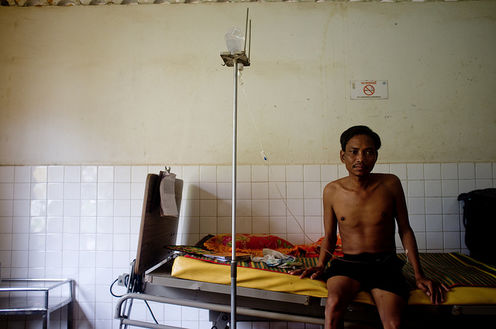
The federal government’s Mid-Year Economic and Fiscal Outlook announcement this week to cut the foreign aid budget by a further A$3.7 billion over three years is unprecedented. The current government has slashed the aid budget by a total of A$11.3 billion over the coming four-year period. The cuts in foreign aid comprise 27% of all budget cuts announced in 2014.
The commonly used indicator of a wealthy country’s generosity is the percentage of gross national income (GNI) allocated to foreign aid. While both major parties were committed as recently as early 2013 to reaching 0.5% of GNI, this year’s figure is 0.32% and it will fall to 0.22% next financial year. According to the OECD, this is around one-quarter of what the Scandinavian countries give, one-third of what the conservative government in the UK contributes, and it’s even less than recession-hit Portugal, Ireland and Iceland.
To illustrate the short-term impact of these aid cuts, let’s look at the health sector. If the proportion of the aid budget allocated to health remains at the current 16%, this means that A$1.8 billion is no longer available to help populations in our neighbouring countries achieve a decent standard of health.
Every three years, the Copenhagen Consensus Center assembles some of the world’s leading economists to rank the cost-effectiveness of development interventions; the most recent meeting in 2012 included four Nobel Laureates. In a submission to the Australian Senate Committee on Foreign Affairs and Trade in early 2014, the Center included 11 health interventions among its top 16 “value-for-money” solutions to global development challenges.
This follows the landmark 2001 Report by the Commission on Macroeconomics and Health, which succinctly summarised the importance of health to economic growth as follows:
Health is the basis for job productivity, the capacity to learn in school, and the capability to grow intellectually, physically, and emotionally. As with the economic well-being of individual households, good population health is a critical input into poverty reduction, economic growth, and long-term economic development at the scale of whole societies.
The lost A$1.8 billion could have been invested in strengthening health systems in neighbouring countries and, using the Copenhagen Consensus cost-effectiveness data, achieved each of the following results over the next four years:
-
The prevention and treatment of malnutrition in two million children, thus ensuring better educational outcomes and employment opportunities (A$240 million)
-
The prevention of 100,000 child deaths through expanding the coverage of immunisation programs (A$400 million)
-
The prevention of 50,000 child deaths from malaria by providing access to more affordable and effective anti-malarial drugs (A$200 million)
-
The prevention of 100,000 adult deaths from tuberculosis by expanding tuberculosis diagnosis and treatment programs ($600 million).
In addition, according to data from the Guttmacher Institute, there would still be adequate funds to:
-
Prevent 30,000 maternal deaths during pregnancy or childbirth through improved antenatal services and emergency obstetric care (A$200 million)
-
Prevent 900,000 unintended pregnancies through improved family planning services (A$30 million).
Finally, data from WaterAid indicate that 1.5 million rural families could be provided with clean water, household latrines, and hygiene education, which would reduce the rate of diarrhoea in young children by at least 30% (A$130 million).
There is no information on the nature of cuts to the aid program on the website of the Department of Foreign Affairs and Trade (DFAT). But previous statements by minister Julie Bishop indicate that the aid program will further narrow its geographic focus to almost exclusively Southeast Asian and Pacific countries, as well as humanitarian aid in the event of disasters. Sub-Saharan Africa and South Asia are likely to drop off the Australian foreign aid map.
Any further predictions would be unsubstantiated conjecture.
Despite frequent media criticism, foreign aid is a runaway success story. The number of deaths worldwide in children under five years of age has declined by half since 1990, from 12.7 million to 6.3 million in 2013. As a result of innovative foreign aid, the percentage of the world’s population living in extreme poverty has dropped from 36% in 1990 to 15% now. It is a much more equitable, safer and wealthier planet as a result.
Over the past five decades, strong economic growth in countries such as South Korea, Taiwan, China, Malaysia, Thailand, Indonesia, and Vietnam has yielded significant health, education and quality of life dividends for their populations. Each of these countries was at one time a recipient of foreign aid. They are all now important trading partners with Australia.
However, in the Asia-Pacific region, hundreds of millions of people remain trapped in extreme poverty – the majority living in what are classified as middle-income countries. These disadvantaged people lack access to the benefits of socioeconomic development and neither consume from nor contribute to the market economy.
Singling out the aid sector for a second round of budget cuts is not only demonstrably unfair, it shows the government doesn’t value foreign aid as an investment in our own nation’s future. While providing development assistance to our poorer neighbours is the morally right thing to do for a wealthy nation such as Australia, it is also a wise investment in our own future prosperity and security.
Michael Toole, AM does not work for, consult to, own shares in or receive funding from any company or organisation that would benefit from this article, and has no relevant affiliations.
